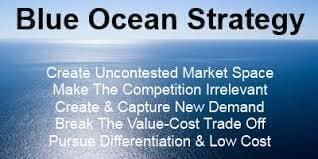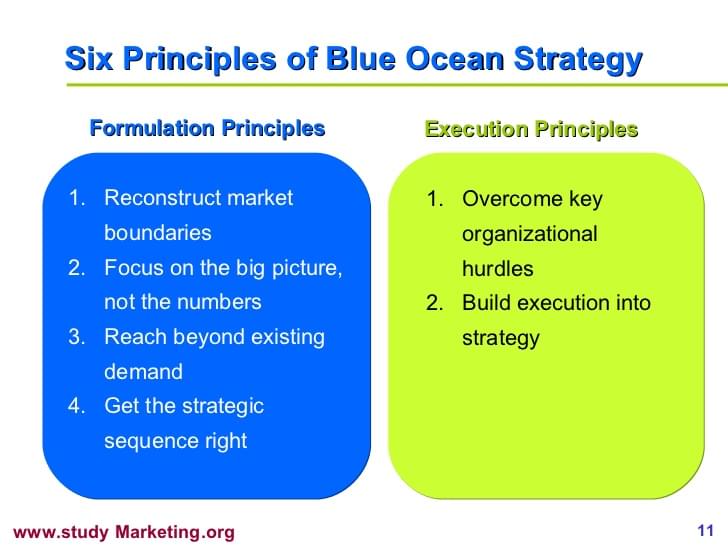Significance of Blue Ocean Strategy in Textile Industry :
Rushin H Vadhani
AGM-Marketing
AYM Syntex Ltd.
(Formely Welspun Syntex Ltd)
What if your business could be in a league of its own? Instead of competing with others in your industry, what if you were setting the pace, creating unique products and profiting from lucrative new markets? Generating that kind of environment is the goal of blue ocean strategy, a business theory that suggests companies are better off searching for ways to gain “uncontested market space” than engaging in traditional competition. The term is derived from the book “Blue Ocean Strategy” by W. Chan Kim and Renee Mauborgne. It describes how companies traditionally work in “red ocean” conditions, where businesses viciously fight against each other for a share of the marketplace. Instead, according to the blue ocean strategy, organizations should find a way to work in a marketplace that is free of competitors.
Leading companies will succeed not by battling competitors, but by systematically creating “blue oceans” of uncontested market space ripe for growth. The strategy represents the simultaneous pursuit of high product differentiation and low cost, thereby making competition irrelevant. The question arises how many industries that are unknown today will exist in the future? Considering history as any predictor … the answer is many. Companies have a huge capacity to create new industries and re-create existing ones, a fact that is reflected in the deep changes that have been necessary in the way industries are classified. Blue ocean strategy is successful because it simultaneously attracts large numbers of customers while raising the cost of competition.
Blue Ocean Strategy Vs Red Ocean Strategy :
The traditional competition-based strategies (red ocean strategies) are necessary, they are not sufficient to sustain high performance. Companies need to go beyond competing. To seize new profit and growth opportunities they also need to create blue oceans. Competition based strategies assume that an industry’s structural conditions are given and that firms are forced to compete within them, an assumption based on what academics call the structuralism view, or environmental determinism. To sustain themselves in the marketplace, practitioners of red ocean strategy focus on building advantages over the competition, usually by assessing what competitors do and striving to do it better. Here, grabbing a bigger share of the market is seen as a zero-sum game in which one company’s gain is achieved at another company’s loss. Hence, competition, the supply side of the equation, becomes the defining variable of strategy. Here, cost and value are seen as trade-offs and a firm chooses a distinctive cost or differentiation position. Because the total profit level of the industry is also determined by structural factors, firms principally seek to capture and redistribute wealth instead of creating wealth. They focus on dividing up the red ocean, where growth is increasingly limited.
Blue ocean strategy, on the other hand, is based on the view that market boundaries and industry structure are not given and can be reconstructed by the actions and beliefs of industry players. This is what the author calls the reconstructionist view. Assuming that structure and market boundaries exist only in managers’ minds, practitioners who hold this view do not let existing market structures limit their thinking. To them, extra demand is out there, largely untapped. The crux of the problem is how to create it. This, in turn, requires a shift of attention from supply to demand, from a focus on competing to a focus on value innovation – that is, the creation of innovative value to unlock new demand. This is achieved via the simultaneous pursuit of differentiation and low-cost. As market structure is changed by breaking the value/cost tradeoff, so are the rules of the game. Competition in the old game is therefore rendered irrelevant.
By expanding the demand side of the economy, new wealth is created. Such a strategy therefore allows firms to largely play a non–zero-sum game, with high payoff possibilities.
Finding blue oceans in today’s competitive business scenario :
To discover an elusive blue ocean, the author suggests the “Four Actions Framework.” This is used to reconstruct buyer value elements in crafting a new value curve. To break the trade-off between differentiation and low cost and to create a new value curve, the framework poses four key questions:
The analysis based on above 4 points pushes leaders to simultaneously pursue differentiation and low cost in order to break the value-cost trade-off. The questions also spotlight companies that are focused only on raising and creating, in the process lifting the cost structure and often over-engineering products and services.
Key Principles & Significance of Blue Ocean Strategy in Textile Industry:
- It pursues differentiation and low cost :
Blue ocean strategy is based on the simultaneous pursuit of differentiation and low cost. It is an “and-and,” not an “either-or” strategy. Conventional wisdom holds that companies can either create greater value for customers at a higher cost or create reasonable value at a lower cost. Here strategy is seen as making a choice between differentiation and low cost. In contrast, blue ocean strategy seeks to break the value-cost tradeoff by eliminating and reducing factors an industry competes on and raising and creating factors the industry has never offered. This is what we call value innovation.
Value innovation is distinctively different from the competitive strategic approach that takes an industry structure as given and seeks to build a defensible position within the existing industry order. The strategic logic of value innovation guides companies to identify what buyers commonly value across the conventional boundaries of competition and reconstruct key factors across market boundaries, thereby achieving both differentiation and low cost and creating a leap in value for both buyers and the company.
Recently Van Heusen has introduced shirts called Easy Wash & Zero detergent. The brand is creating features that industry or competition never offered thus changing the dynamics of competition by offering value innovation to customers.
A revolutionary innovation from Van Heusen that allows you to remove everyday stains with just a dab of water. Offering a unique blend of fashion & technology, every Easy Wash shirt combines the best of liquid repellence & stain release functions on the finest fabrics .Perfect for those who know a change of shirt is quite a compromise.
- It creates uncontested market space :
Blue ocean strategy doesn’t aim to out-perform the competition. It aims to make the competition irrelevant by reconstructing industry boundaries. Whereas conventional strategic approaches drive companies to define their industry similarly and focus on being the best within it, blue ocean strategy prompts them to break out of the accepted boundaries that define how they compete. Instead of looking within these boundaries, managers need to look systematically across them to create blue oceans – new and uncontested market space of new demand and high profitable growth.
Raymonds introduced Technosmart fabric is perfect example of Value Innovation & creating blue ocean strategy of creating new market segments by offering value added features like UV protection ,wrinkle free , smooth touch & breathable fabrics.
The brand is making competition irrelevant , creating & capturing new demand with value-cost trade off & creating high profit growth.
- It provides a step-by-step process :
From assessing the current state of play in an industry, to exploring the strategic paths to new market space, to understanding how to convert noncustomers into customers, blue ocean strategy provides a clear four-step process to break away from the competition and create a blue ocean of strong profitable growth. The four-step process is designed around the concepts and analytic tools of blue ocean strategy and fair process. It allows managers and their teams to develop rigorous and concrete strategies while capturing the big picture. In this way, it presents an alternative to the existing strategic planning process, which is often criticized as a number-crunching exercise that keeps companies locked into making incremental improvements.
- It maximizes opportunity while minimizing risk :
Blue ocean strategy is an opportunity-maximizing risk-minimizing strategy. Of course any strategy will always involve risks – be it red or blue. However, blue ocean strategy provides a robust mechanism to mitigate risks and increase the odds of success. A key framework here is the Blue Ocean Idea Index. The Blue Ocean Idea Index lets you test the commercial viability of your blue ocean ideas and shows you how to refine your ideas to maximize your upside while minimising downside risks. It allows you to answer four key questions: First, is there a compelling reason for people to buy your offering? Second, is your offering priced to attract the mass of target buyers so they have a compelling ability to pay for it? Third, can you produce your offering at the strategic price and still earn a healthy profit from it? And finally what are the adoption hurdles in rolling out your idea and have you addressed these upfront? The first two questions address the revenue side of your business model. They ensure that you create a leap in net buyer value. The third question ensures the profit side of your business model. And the last question ensures that you have given good thought and addressed externalities that could trip up even the best new idea.
- It builds execution into strategy :
The process and tools of blue ocean strategy are inclusive, easy to understand and communicate, and visual – all of which makes the process non-intimidating and an effective path to building execution into strategy and the collective wisdom of a company. Equally as important, blue ocean strategy is a strategy that expressly joins analytics with the human dimension of organisations. It recognises and pays respect to the importance of aligning people’s minds and hearts with a new strategy so that at the level of the individual, people embrace it of their own accord and willingly go beyond compulsory execution to voluntary cooperation in carrying it out. To achieve this, blue ocean strategy does not separate strategy formulation from execution. Instead, blue ocean strategy builds execution into strategy from the start through the practice of fair process in the making and rolling out of strategy.. They allow companies to stand apart in the speed, quality, and consistency of their execution and to implement strategic shifts fast at low cost.
- It shows you how to create a win-win outcome :
With its integrated approach, blue ocean strategy shows how to align the three strategy propositions – value, profit, and people – to ensure your organisation is aligned around your new strategy and that it creates a win for buyers, the company, and for employees and stakeholders. For any strategy to be successful and sustainable an organisation must develop an offering that attracts buyers; it must create a business model that enables the company to make a tidy profit; and it must motivate the people working for or with the company to execute the strategy. While good strategy content hinges upon a compelling value proposition for buyers and a robust profit proposition for the organisation, sustainable strategy execution is based largely on a motivating people proposition. The alignment of the three propositions proposed by blue ocean strategy ensures that an organisation is taking a holistic approach to the formulation and execution of strategy. Together the three propositions provide an organising framework for creating a winning strategy that will benefit buyers, the company, as well as internal and external stakeholders.
To conclude author strongly believes creating blue oceans will build brands. The competitive business scenario & ever increasing demand of customers for same product lines will significantly call for value innovations & change of business models .The strategies will have to be realigned from traditional focus of beating the competition , exploring consumer demands to creating & capturing new demands & making competition irrelevant. The next generation of business will be creating new market boundaries with new segment of customers & thats where blue ocean strategy is so powerful that timely strategic move can create brand equity that lasts for decades.
Key References :
- The Blue Ocean Strategy Book by Chan Kim and Renee Mauborgne
- corporatestretgy.com
- knowledge.instead.edu
- hbr.org
- raymondsindia.com
- Times of India advertisements of Technosmart Fabric & Van Heusen Easy Wash Shirt
*Disclaimer: The views and opinions expressed in this article are those of the author in his personal capacity of knowledge & perspectives on the mentioned subject .






